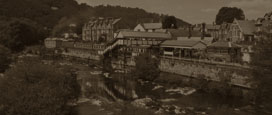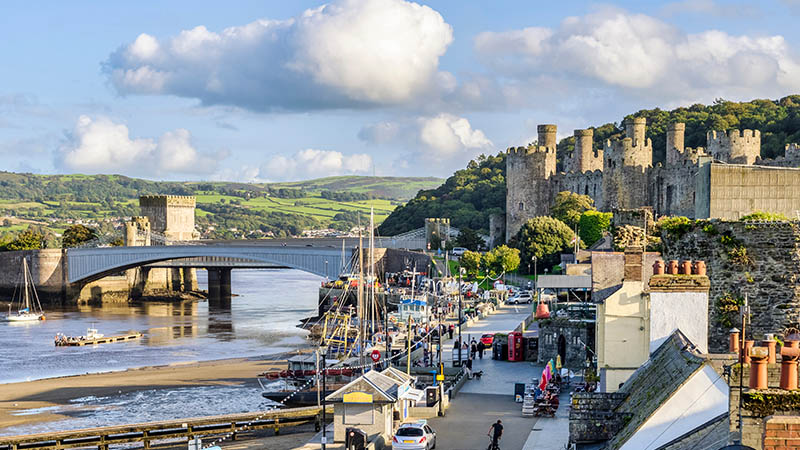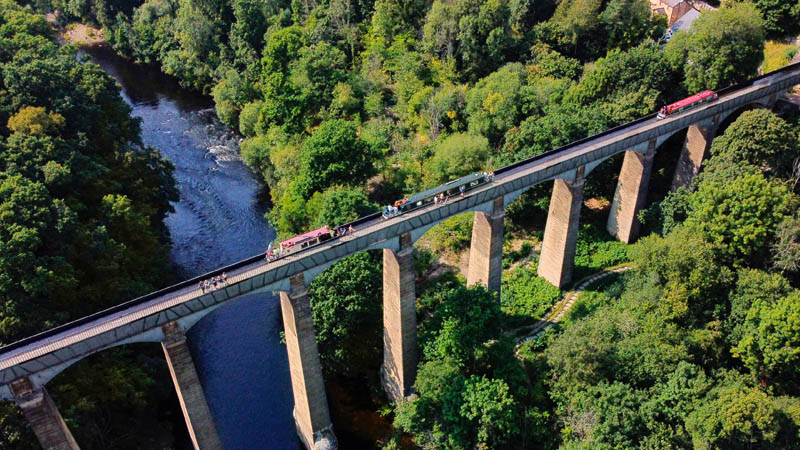Castle & Site Tours
There is so much on offer with tours designed to best suit your interest across the Dee Valley, Conwy, and into Eryri (Snowdonia). Whether it’s a trip to Beddgelert to trace the story of Llywelyn Fawr’s loyal hound; travelling in the footsteps of pilgrims at Basingwerk Abbey or St. Winnifred’s Well; a trip back to the bad old days in Ruthin Gaol, followed by afternoon tea at Ruthin Castle; or a leisurely long boat ride, pulled my might shire horses, many wonderful adventures await you
Wales boasts over 600 castles, many hidden in plain sight and worth exploring. Their size, defenses, and ambition impress visitors. Tours cover Edwardian castles like Conwy, Caernarfon, Harlech, and Beaumaris—part of a UNESCO World Heritage Site—as well as earlier Welsh Princes' castles, including Dinas Bran, Criccieth, Dolbadarn, and Dolwyddelan.
The Industrial Revolution spurred infrastructure growth, starting with canals like those in Llangollen, including the Pontcysyllte and Chirk Aqueducts. Railways followed, and today, visitors can ride the 10-mile heritage railway from Llangollen to Corwen on a steam or diesel train.
Conwy Castle and medieval town walls
A popular tour which begins outside the mighty walls of Edward I’s impregnable fortress, this tour tells the story of this English King’s attempted suppression of the Welsh people in the Middle Ages, the building of his castle which sits atop a rock outcrop for all to see. With a tour of the castle, bringing the sights, sounds and stories of the castle and surrounding town to life, we can then scale the town walls, which are also part of the UNESCO World Heritage site, before descending into the heart of the beautiful walled town, with its parish church of St. Mary’s and All Saints in the centre and sitting on the site of the Cistercian Abbey which was removed and relocated by Edward as he build his castle. Passing, or even visiting Plas Mawr, the finest Elizabethan town house in Britain, we pass numerous coaching inns which remind us of the importance of this town and its place on the route from London to Holyhead and on to Ireland, and, finally, passing outside the town walls down to the harbour where we will find Britain’s smallest house, views across the Conwy estuary and of the wonderful Grade I suspension bridge built by Thomas Telford between 1822 – 1826. This is a perfect place to stop and to try local food, from the world famous Conwy mussels, to the best local ice cream, Conwy is home to many local and independent food outlets which make this a perfect stop for a foodie as well as the lover of history!
Pontcysyllte Aqueduct
Another of the wonders of North Wales and, together with the 11 miles of canals, Horseshoe Falls which feeds this waterway and Chirk Aqueduct forms part of the UNESCO World Heritage Site. The name in English means ‘Bridge that connects’, and it not only connects the difficult terrain which needed to be crossed to form the canal network, but also early and modern feats of engineering. Built in 1805, the sheer size and scale of this masterpiece strikes you as you look up at the 18 towering arches, or, if you have a head for heights, down from ‘the stream in the sky’. This tour will interpret the history of this site, from its design and construction by the great Thomas Telford and William Jessop to stories of those who uses and still use this canal system. As the longest aqueduct in Great Britain and the highest in the world, it truly is a marvel to see the sheer determination of man in this form.
St Asaph cathedral, Basingwerk Abbey, Valle Crucis and St. Winefride’s Well
Religion forms an important part of Welsh culture, dating back many thousands of years, the worship of God and Gods, can be traced from the earliest people through sites such as Bry Celli Du and the numerous standing stones and stone circles which dot the landscape of North Wales, through to the magnificent Cistercian Abbeys which still stand at Basingwerk and Valle Crucis. These spectacular sites show the sheer importance of religious worship both then and, in Basingwerk’s case, today as it forms the beginning of the North Wales Pilgrim’s Way which stretches 135 miles (218km) to Bardsey Island, ‘the island of 20,000 saints’. Situated close by is the striking site of St. Winefride’s well. Reputedly the oldest continually visited site of pilgrimage, visitors have been making their way to this holy spring for centuries. The story which surrounds its founding is a brutal one, however, over the following 1, 300 years, this has become a place of quiet reflection and certainly sooths the soul when visited. Wales is certainly home to -ests! The longest, highest aqueduct, the smallest house, the longest place name, and it doesn’t disappoint in having the smallest cathedral in Britian in St. Asaph. It may be small, but its history is a big one, with the site being a place of worship for over 1,400 years, the cathedral itself dates from the 13th Century and its importance was cemented when William Morgan became Bishop of St. Asaph. His lasting legacy and the event which changed the way religion was practised in Wales with the translation of the whole of the bible into Welsh, an important moment for the Welsh Language which continues to thrive here in North Wales.
Famed for its many castles, a visitor to the area will also be struck by the number of religious sites and places of worship within each hamlet, village and town and tours can also be tailored to trace ancestors who may have left the area owing to their religious beliefs to settle in other areas of the world.







